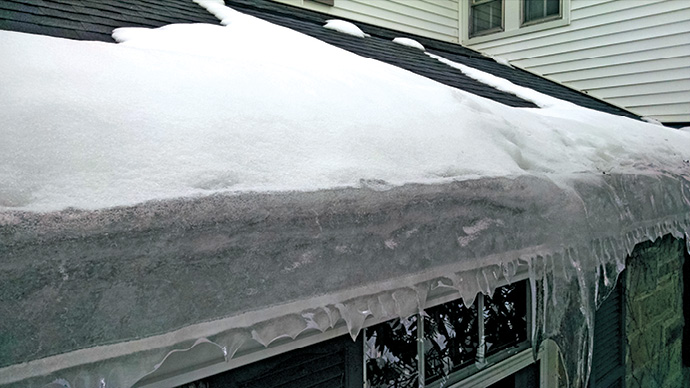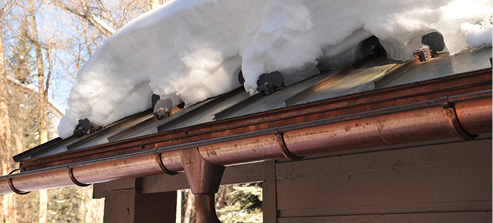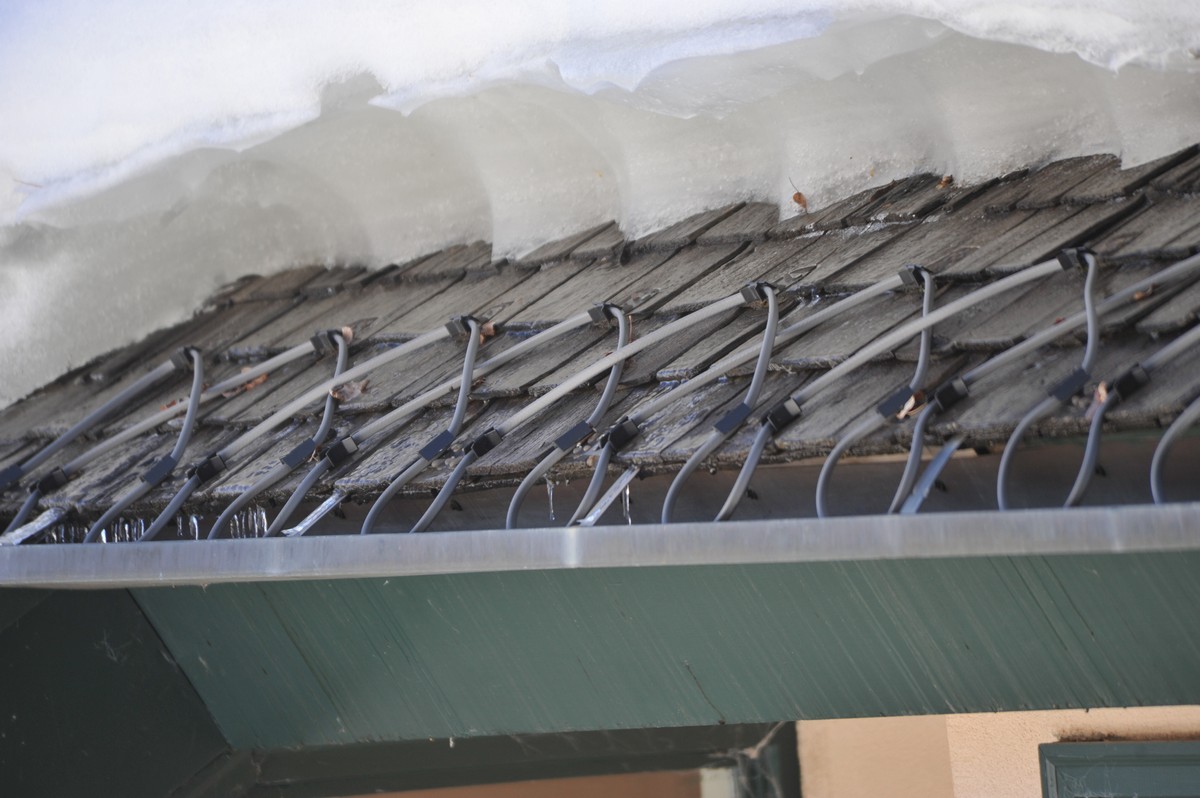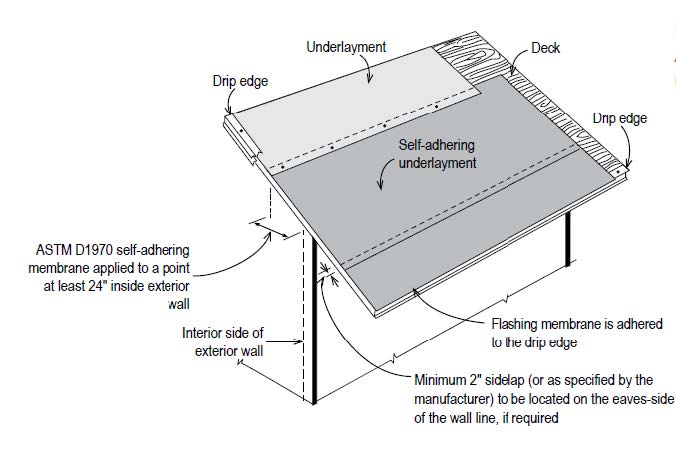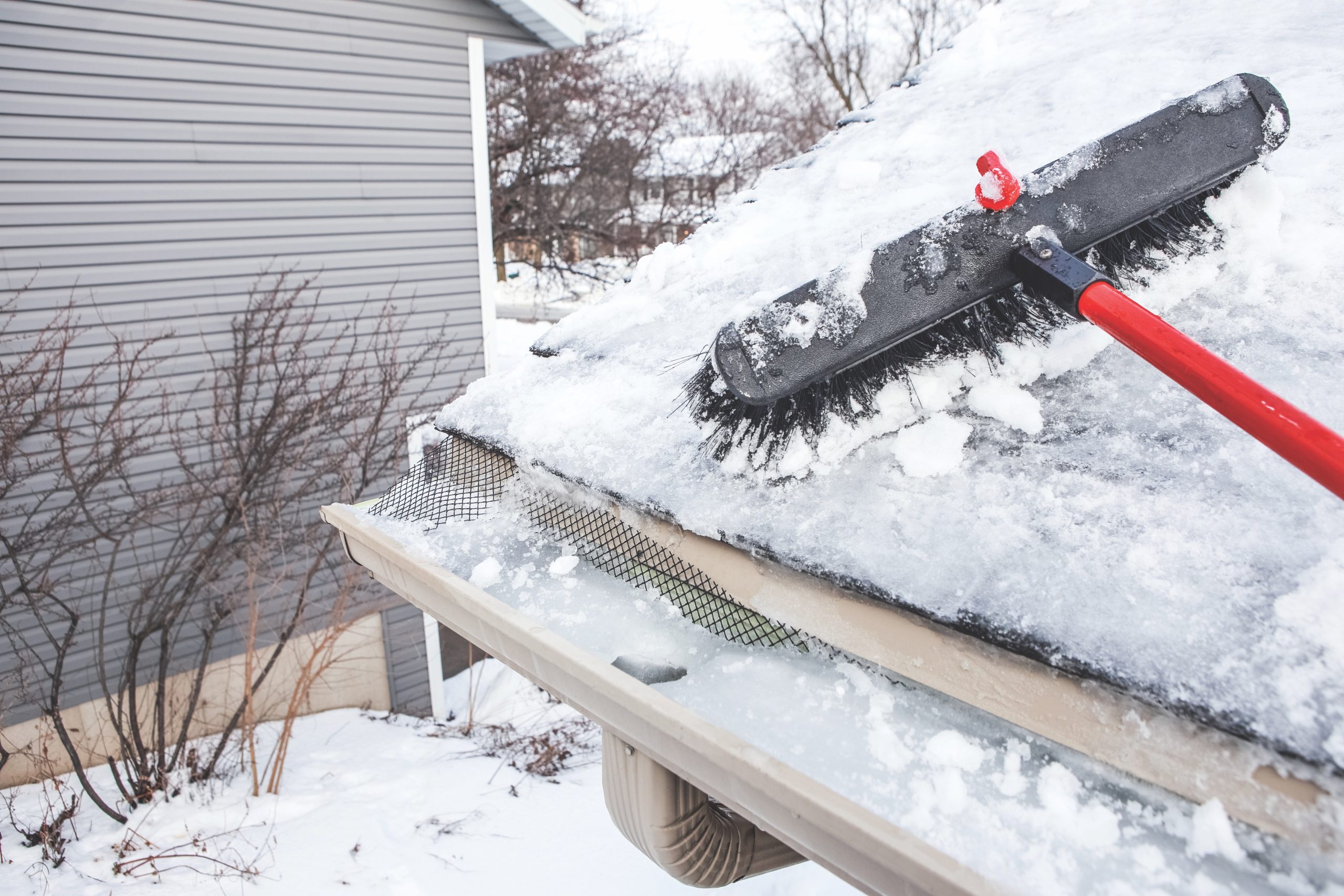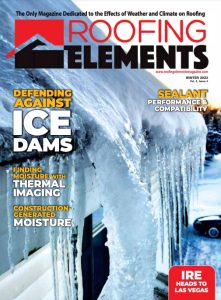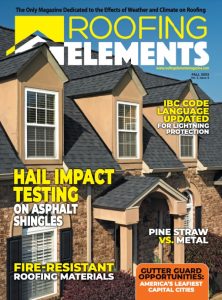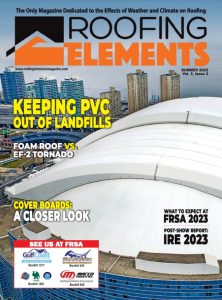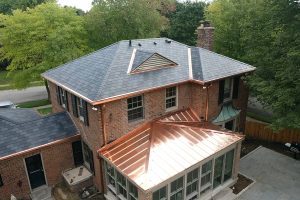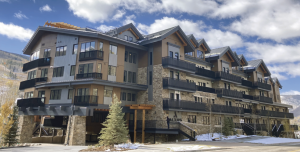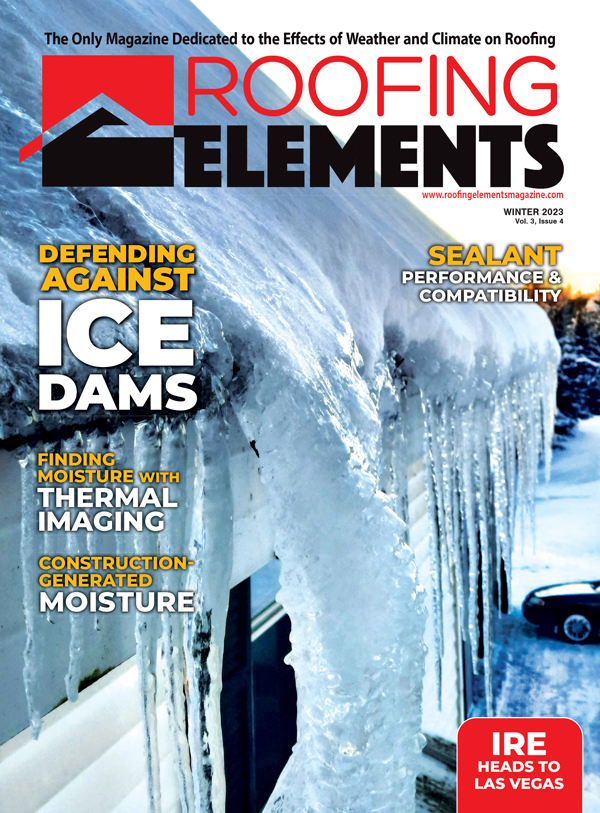Using a “total system” approach to battle Mother Nature
By Paul Scelsi
An ice dam, a blockage of ice formed at or near the roof’s lowest edge, develops when snow on a roof melts unevenly, primarily due to imbalanced roof deck temperatures. The melting usually starts near the peak of the roof, where it’s warmest, and refreezes when it reaches the lowest (and coldest) section of the roof. Any additional snow melt in the next hours or days runs into the dam. Once an ice dam starts, all melting water hits the dam and begins to back up, potentially penetrating underneath and between the roofing material. The water easily finds even the tiniest of cracks, ultimately leading to an interior leak.
Sabrina Johnson, Owner of KDCO Home Improvements in Akron, Ohio, sees her share of ice dams annually and shared how best to fight them. Let’s be perfectly clear right up front: Mother Nature will win in the end. But there are strategic steps you can take to reduce the frequency and severity of ice dams and the potential damage they can cause.
“Ice dams are very common in our area,” said Midwest-based Johnson. “More often than not, the calls I receive involve someone with a new roof and new attic insulation, yet they’re still getting ice dams and don’t understand why. There are a lot of variables as to why. With our [recent] milder winters from warm to cold, we’re seeing an even bigger occurrence of ice dams than years ago.” A sudden warmup in the winter (which can speed up the freeze-thaw cycle) as well as a substantial rain event with already frozen gutters can trigger a rush of ice dam phone calls from homeowners.
“We always know when we’re going to get those phone calls. Homeowners say, ‘Can you bring the rake when you get here because I have stalactites growing off of my gutters,’” Johnson laughed. “We don’t like to hear that, but that’s what homeowners want. I tell them, ‘I have a better idea. We’re going to have to discuss more than a rake.’”
Here’s what Johnson hears about from homeowners and eventually is called to the scene to investigate:
• Damaged shingles
• Water damage to the house overhang (soffit and fascia)
• Damage to the roof deck
• Damage to interior walls and ceilings
• Wet attic insulation (reducing its insulating abilities)
• Gutter damage
• Damaged interior floors
• Framing damage
• Mold
• Large icicles dangling from the roof edge, waiting to fall
• Ants and pests, which are attracted to the moisture
• Damage to any items stored inside the attic
There’s one more to add to the list: “There’s a potential problem that is very dangerous that most people do not take into consideration,” Johnson said, adding, “If the ice dams are creating a leak into your attic, that can wet any electrical wiring of ceiling fans or recessed can lights, which could become a hazard if not addressed.”
Fight Back: Attic Insulation
When homeowners use a rake (or ask the roofing contractor to use a rake) to remove the snow from the roof in an attempt to fight the ice dam, it may help remove the snow, but it’s not addressing the root cause of the ice dam. Not to mention, raking can potentially damage the roof itself. “If you’re raking shingles or throwing salt on shingles, you’re damaging the shingles by loosening or removing the granules. You’re prematurely deteriorating a product that was meant to last decades,” said Johnson.
What will help fight the ice dams? A total system approach of attic insulation and attic ventilation.
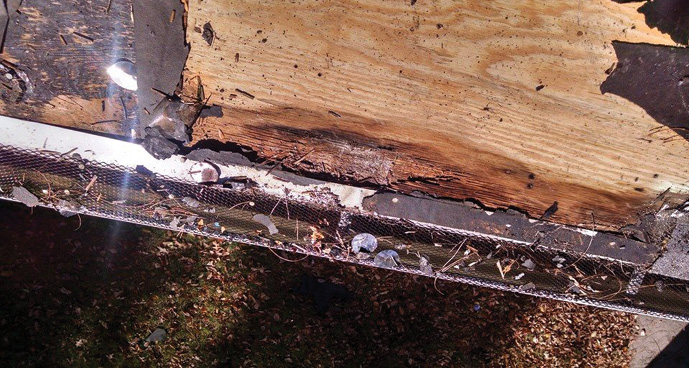
This roof deck has been damaged by repeated moisture intrusion due to ice dams. Photo courtesy of Air Vent.
Attic insulation helps keep the warm air inside the house interior and out of the attic. It’s the first line of defense against fighting ice dams, and the best step toward minimizing the amount of warm indoor air that escapes into the attic. The goal is to help keep the attic temperature as close to the outdoor temperature as possible so any snow on the roof can melt evenly. The amount of attic insulation needed (expressed as R-value, or Resistance to heat flow) depends on the home’s geographic climate zone.
“When you update attic insulation, it’s an absolute must to make sure you’re installing attic insulation baffles down into the soffit, allowing proper airflow from the intake vents to the exhaust vents. The insulation baffles prevent the intake vents from becoming blocked,” said Johnson.
Simply seeing attic insulation inside the attic does not guarantee it’s the correct R-value needed for the home, even if it was originally the correct R-value. “I like to use the analogy of a bag of cotton candy you might get at a fair,” said Johnson. “It’s fluffy. You’re excited. But if you leave that cotton candy on the countertop for a few days, it will shrink. The same is true with fiberglass insulation. Its insulating factor is the air between the fiberglass. Over time, it will settle or shrink and what was once, say, an R-30 is now only an R-15, for example. Visually, you think there is attic insulation, but it’s not doing its job. It’s important to evaluate and upgrade attic insulation as needed. It’s just a much better situation to be properly insulated.”
Insulating bath fan ductwork is also important, said Johnson, as is ensuring that the ductwork terminates through the roof peak or out to the side of the house—not to the soffit and certainly not into the attic.
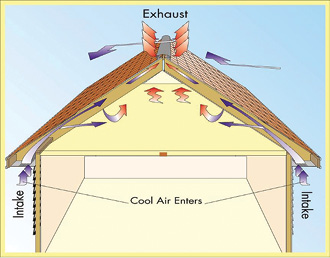
Insulation + Ventilation = A Total System
Approach. Graphic courtesy of Air Vent.
Fight Back: Attic Ventilation
Some indoor heated air from the living space may escape into the attic even after the best efforts to insulate the attic and to air seal “bypasses” or openings to the attic (electrical chases, attic access doors, recessed lights, etc.). That’s where a balanced system of intake vents and exhaust vents comes into play.
Attic ventilation actually assists the attic insulation. It does this by bringing cool outdoor air into the attic through the intake vents; that airflow then flushes out warm, moist air that may have built up inside the attic and pushes it through the exhaust vents. As a result, the overall attic temperature is closer to the ambient outdoor temperature along the entire underside of the roof—reducing the roof’s hot and cold spots that invite ice dams. The snow-covered roof can melt as uniformly as possible, minimizing the chance for ice dams.
“Without balanced attic ventilation at both the soffits and the ridge areas—or at least near the roof peak—no matter what system of ventilation you install, the chance for ice dams will continue,” said Johnson. “The ridge vents, box vents, and power fans (all of which are exhaust vents) will not work optimally without having intake ventilation. You have to address both the intake and the exhaust as a total package.”
“I feel sorry for the homeowners when a roofing contractor comes in and installs a ridge vent, telling the homeowner how effective ridge vents are, and the homeowner thinks they have the perfect roofing system,” shared Johnson. “But that’s not the case if a siding contractor was hired years earlier before the roof was installed or after the roof was installed and the soffits were only partially vented soffit or non-vented soffit.” In those cases, the intake ventilation is significantly reduced, if not completely eliminated, which negatively impacts the ridge vent’s performance.”
“If you go into the attic and you pull the insulation baffles out and you do not see daylight, guess what?” said Johnson. “Even if there is vented soffit on the outside of the house in the overhang system, that tells me the previous contractor did not cut the soffit so air can actually flow into your attic and assist with that ‘cool air in, hot air out system.’ So now you do not have the perfect scenario to help reduce ice dams.” The daylight Johnson is referring to is a visual clue to make sure the intake vents have actual openings.
If you’re installing a new roof but the homeowner doesn’t want to spend the money to redo the soffit to fix the insufficient intake airflow, rooftop intake vents are an option that would be installed at the time of the new roof installation.
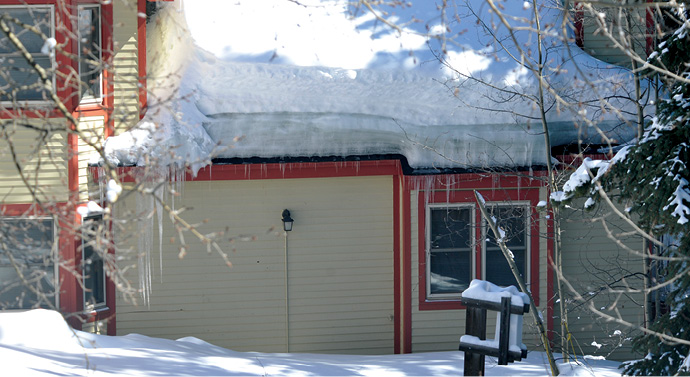
Ice dams of this size weigh more than what the roof is designed to hold. Plus, the water from snow melt seeks the path of least resistance, leading to leaks, mold, and other damage. Photo courtesy of HotEdge.
Ice Dams in the South
Obviously, ice dams are a major concern in Northern climates, but they can and do occur in Southern climates, too. “I live in the South. And although we obviously don’t get the same amount of snow and ice as the North, we do get the occasional heavy snow and a few ice storms,” said Jake Jacobson, Vice President of SF5 Construction in Little Elm, Texas. “I have seen ice on the north side of the roof in the early fall. Not only is this adequate time for a potential leak to occur, but when the ice melts rapidly, the falling icicles create a dangerous situation. I always tell homeowners, ‘It only takes one storm to create an ice dam that could cause a leak.’”
When Mother Nature wins, a water protective membrane on the roof under the shingles can help minimize the damage that results from an ice dam. Johnson has an installation tip to share: “Roll the water protective membrane down from the roof edge onto the fascia and gutter line by about 1½” to cover the crevice formed by the intersection of the fascia and the roof deck,” she said. “If you don’t, and there’s an ice dam, the melted ice can enter into that crevice to the top plate of the house, then run down the wall and down over a window or door header, rotting the sidewall of the house as well as getting into the attic. It’s very important to roll the protective membranes over the fascia and gutter line to hopefully better prevent ice dams from backing up in between those two substrates.”
Johnson is passionate about her craft and serving her customers well. Educating homeowners about ice dam troubles and how to fight them is a priority for her. “We’re trying to make all of the homes we work on be the best investment possible.”
Paul Scelsi is Marketing Communications Manager at Air Vent Inc. and leader of its Attic Ventilation: Ask the Expert™ in-person seminars (www.airvent.com). He hosts the podcast, “Airing It Out With Air Vent,” and he’s chairman of the Asphalt Roofing Manufacturers Association Ventilation Task Force. He is the author of the book, Grab and Hold Their Attention: Creating and Delivering Presentations that Move Your Audience to Action.

